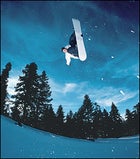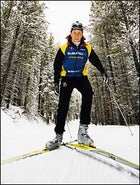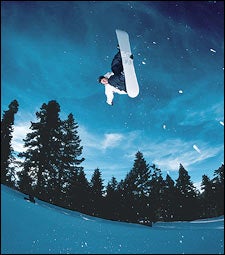HALFPIPE HUCKING
More action online
What does it take to manipulate a sail filled with 12 tons of force in less than five seconds? For a look at the specialized workout of the team favored to win this year’s America’s Cup, log on to www.outsideonline.com. The Oracle/BMW racing team program involves sand dunes, sweat, and more stamina than you thought a sailor would ever need. We have liftoff: Burton snowboarder Keir Dillon in his natural element
We have liftoff: Burton snowboarder Keir Dillon in his natural element At 25, BURTON GLOBAL snowboarder Keir Dillon’s job duties include fine-tuning his McTwist 900—a front flip with two and a half rotations executed eight feet above the lip. For halfpipe dreamers, his first words of advice are simple: “You’re going to fall tons. If you don’t, you’re not progressing.” But before you take on the hordes of sixth-graders channeling Danny Kass at your local pipe, you need to master some basics. Dillon says anybody hoping to twist off the top of the pipe must be able to do front- and backside 180s off ordinary jumps. Another word to the wise: Spend time in the gym on a wobble board, executing medicine-ball twists to hone balance and build up your obliques.
When you’re ready to rip, start by sliding down the halfpipe, carving up the walls two feet higher each time, making sure to hop, not slide, onto the opposite edge of your board when reaching the apex of each turn. When you’ve nailed five straight runs, try these steps: 1) From the top of the pipe, drop into the chute at a 45-degree angle to the fall line so you’ll generate enough speed. Keep your weight on the board’s high-side edge—relative to the slope of the hill, not the walls of the pipe—bend your knees, and maintain the edge all the way down, across the flat of the pipe, and back up the other side. 2) As you approach the lip, keep your shoulders aligned with your board. Pop off the lip into the air, then simultaneously grab the board with your trailing hand and rotate your torso 90 degrees. 3) Let go of the board and land in a crouch on the high-side edge with your weight distributed evenly over the board.
“To get even a foot above the lip could take a while,” says Dillon, who admits it took him weeks to master aerials. For the rest of us, that translates into a long season of tumbles into the great white ravine—but who said big fun was easy?
Steals

Oz on $110.93 a Day United Vacations, in association with the Australian Tourist Commission, is offering a 15-day Ultimate Road Trip package for a mere $1,664. But act now: The deal is for travel dates between February 24 and March 21, 2003. The bargain price includes airfare from Los Angeles to Sydney, four nights in Sydney, followed by a five-day road trip—rental car and hotels included—culminating in four nights in Melbourne, your departure city. Expect austral-summer heat and 600 miles of beaches between Sydney and Melbourne. Contact: United Airlines, 800-917-9246, .
Frutti di Malta Ah, Malta in February… Well, maybe $699 for a flight from New York, Boston, or D.C., a seven-night stay at any four-star hotel in the cities of Valletta, Sliema, or St. Julian, and crisp Mediterranean breezes will seduce you. Hike to tiny fishing villages along the craggy coastline, or scuba dive in the caves along Gozo, one of Malta’s three inhabited islands. The offer includes breakfasts and is good through March 31, 2003. Contact: The Malta Tourist Office, 877-466-2582, .
Reserve La Ré;serve Bankruptcy has its benefits: The new owners of Ski La Ré;serve, a resort in the Laurentian Mountains of Quebec whose previous owners filed Canada’s equivalent of Chapter 11 in the nineties, are trying to lure new skiers with their Weekend Package. Stay Friday and Saturday nights at the modest slopeside, 65-room Hôtel Montcalm, enjoy dinners and breakfasts, and ski at La Ré;serve for two days, all for US$161. Not bad for a mountain with a respectable 1,000 feet of vertical, 70 acres of terrain, and about 100 inches of snow annually. Contact: Hôtel Montcalm, 866-424-1333, .
NEW TRIP
Zemu With a View
SEE 28,309-FOOT KANCHENJUNGA from Sikkim’s Zemu Glacier on this 21-day trek from Mercury Himalayan Explorations. Follow the Zemu Chu River through valleys full of rhododendrons, cross 17,000-foot passes, and try to spot snow leopards stalking blue sheep. Cost: $3,600 per person. Contact: Mercury Himalayan Explorations, 212-223-9200, . (Read about further glacial exploits by Mercury founder Colonel Narinder Kumar in ““.)
Tracking an Ice Fall
CANADIAN ICE MONKEY Will Gadd, 35, used to climb the old-fashioned way—swinging one ice ax overhead and throwing the next ax right beside it—essentially swinging twice to move once. But then he asked himself: Why not place each ax above the one thrown previously? Shazam! Gadd, with help from his fellow climbing pals, perfected the method and christened it “tracking.”
“Tracking cuts your total number of placements in half,” says Gadd, who last year was the first ice climber to scale an M12 pitch—it involved surmounting a 30-foot-long ceiling and then a ten-foot-long icicle found outside Banff. The technique, which requires a fair amount of rotational core strength and leg muscle, goes like this: 1) Place your right ax in the ice above your head, at arm’s length and in line with your right shoulder. Hang straight-armed from this secured tool and then step up with both feet into a half crouch. You should have one foot to the left of an imaginary line running straight down from your high tool, and the other foot to the right. 2) Eyeball a spot above your left shoulder, about a foot higher than your right tool, for your next placement. Push up with your legs and pull yourself up with your right arm, using the lower tool in your left hand for balance and additional push. 3) Aggressively remove the left ax by pulling up on it like a pump handle and place it solidly above you in your predetermined spot. Now hang straight-armed from the high tool, move your feet up and under the new high placement, and repeat to the top.
Becoming a Skater
 Drive, then glide: U.S. national cross-country team member Nina Kemppel perfects her ski-ski technique.
Drive, then glide: U.S. national cross-country team member Nina Kemppel perfects her ski-ski technique.“SKATE-SKIING ALLOWS YOU to go 20 percent faster than traditional cross-country skiing,” says Nina Kemppel, 32, a four-time U.S. Olympian. Skating trumps trad-style in other ways, too: Its shorter skis require less waxing, and its sturdier boots help you get out beyond the confines of a groomed doubletrack to ski anywhere you find packed powder.
To blast off, start with your feet together, then flow like so: 1) If you’re left-handed, glide the left ski forward and slightly outward, with your weight centered over it (right-handers, start with your right ski), while simultaneously poling with both arms on either side of you. 2) As you follow through on the poles, shift your weight to your right ski, pushing from the inside ball of your left foot and gliding forward on your right leg. 3) When that glide is complete, push back onto the left leg, and follow with your poles. You should pole with both arms, but only when pushing off your lead leg. “A common mistake is that people get caught in the middle,” says Kemppel. “They don’t commit to one ski. Your head, shoulders, and hips should always be traveling in the same direction as your weighted ski.”


